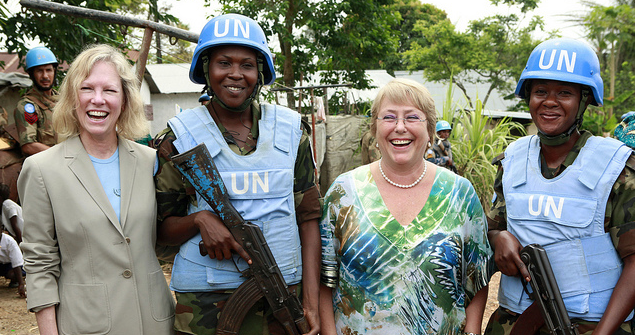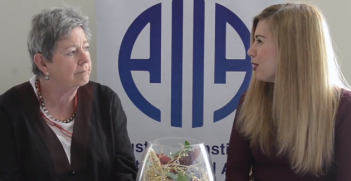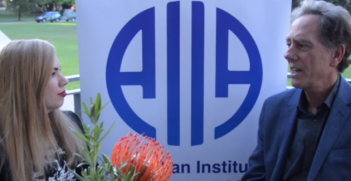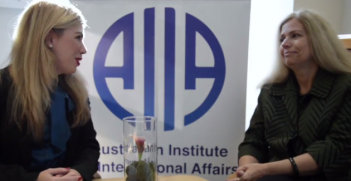Peace Ambassadors: Women in the Conflict Resolution Process

Despite women being active promoters of peace in their communities during times of war, they are alarmingly underrepresented in the formal conflict resolution process. When women are included in the process it provides opportunities to create a more sustainable, positive peace.
Disempowering women by excluding them from peace talks is tantamount to denying society the faculty of half its population. Civilization can, in that wise, only advance by halves – Akin Iwilade
When thinking about women in times of conflict and war, images of submission and suffering arise. Although women suffer disproportionately in times of conflict, their role should not be viewed as one of passivity. Women in conflict zones overcome cultural and social restrictions to fight for peace. They build dialogue between warring parties, stage peaceful protests, collect arms and signatures, lobby politicians, care for the sick and injured and encourage reconciliation in their communities. It is a natural extension of this role of women as activists and caretakers in the home and community to be involved in building peace at the political level, yet women are rarely present in the formal conflict resolution process. Case studies and research highlight that the active involvement of women positively impacts the process and outcome of the formal conflict resolution process.
Opportunities that arise when women are actively integrated
- The achievement of a more holistic and gender sensitive agreement. Representatives at the peace table are usually members of the warring parties. As a result, peace talks often underestimate the depth and width of the crisis and the final agreement fails to address the array of issues contributing to instability. Women often experience all stages and consequences of conflict, providing them with a more complete understanding and insight into the less visible, often underlying problems that can ultimately lead to the eruption of violent conflict.
- The translation of a political peace agreement to the societal level. The signing of a peace agreement created at the negotiating table amongst an inequitable representation of society cannot on its own, result in sustainable peace. Women’s close connection to civil society means that they work to increase social cohesion and tolerance. Sustainable peace is one that is supported and consolidated at the grassroots level.
- The potential to influence the dynamic of the formal conflict resolution process. Progress in the conflict resolution process is often restricted by history, identity and political postures that protract conflict. Delegates who are embedded in the political system may be unwilling to negotiate beyond established positions. Women are usually detached from this formal political system, which places them in a strong position to negotiate and achieve a comprehensive and sustainable peace agreement.
Steps towards the involvement of women in the formal conflict resolution process
- Quotas. Quotes are a successful method of challenging the structure of the conflict resolution process by guaranteeing a minimum percentage of women in official negotiations. A critical mass of 30 percent of women is required to change the tone, style and culture of the conflict resolution process. Quotas are a temporary measure that will empower women to enhance and strengthen the conflict resolution process.
- Gender Expert Support Teams (GESTs). GESTs are comprised of individuals who have technical expertise in the gendered nature of conflict. The presence of a GEST may assist in assuring that all aspects of the final peace agreement support gender equality and women’s rights and that the views of women and other minorities are considered throughout the process. This strategy is currently a part of the WPS agenda and GESTs are present in some UN sponsored processes, but the tactic has the potential to be significantly expanded.
- Training of women’s organisations and delegates of peace talks. Without appropriate training it may be difficult for women to apply their negotiation skills to impact the dynamic of the process and have their views reflected in the final agreement. Training provided to women’s organisations in conflict zones could include technical skills such as understanding the language of the conflict resolution process, writing official documents and representing priorities within a security-framework.
- Consistent funding and support for women’s groups. One of the most significant barriers to the involvement of women in the conflict resolution process is financial. An important step to enhance the WPS agenda would be the establishment of a UN Women’s Organization Trust Fund.
Conclusion
The conflict resolution process has the potential to lay the base for a new and improved society, one based on social justice, equality and human rights. The international community’s approach to conflict resolution needs to change in order to break the cycle of violence and instability in communities around the world. The meaningful and equitable involvement of women in the formal conflict resolution process provides this opportunity and should be viewed as an imperative in achieving sustainable, positive peace.
For the full version of the article, please see the 2014 Emerging Scholars Journal.
Ashleigh Peplow Ball completed undergraduate degrees of International Relations and Communications at Bond University. Since graduating in 2013 she has been working as a project manager for California-based NGO, Mama Hope, in eastern Uganda. Her interests include women’s empowerment, human rights, public health, girl’s education and sustainable development.





